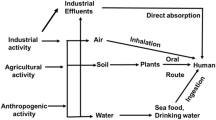Abstract
To clarify species differences in the induction of peroxisome proliferator-activated receptor alpha (PPARα)-related enzymes by di(2-ethylhexyl)phthalate (DEHP) exposure, we investigated the inductions of PPARα and its target genes (mitochondrial medium-chain acyl-CoA dehydrogenase (MCAD) and peroxisomal keto-acyl-CoA thiolase (PT) in liver from mice (CD-1), rats (Sprague–Dawley), and marmosets (Callithrix jacchus) exposed to DEHP. Male mice and rats were treated with 0, 1.25 and 2.5 mmol/kg DEHP for 2 weeks, and marmosets with 0, 0.25, 1.25 and 6.25 mmol/kg DEHP for 15 months by gavage. Hepatic mono(2-ethylhexyl)phthalate (MEHP) levels were significantly higher in mice and rats than in marmosets. The constitutive expression of hepatic PPARα was 5–7 times greater in rats and mice than in marmosets, but DEHP treatment did not induce PPARα-mRNA in all animals. The treatment-induced PT expression detected either by anti-PT antibody or PT-mRNA levels in the liver only from mice and rats, and the induction of the mRNA was greater in the latter than in the former. Thus, DEHP used in this experiment influenced the peroxisomal enzymes in mice and rats, but did not affect the mitochondrial enzymes in any animals or the peroxisomal enzymes in marmosets. These results suggest that there are species differences in the induction of PPARα-related enzymes, especially in peroxisomal enzymes by DEHP treatment, and their underlying mechanism may in part reside in the different constitutive levels of PPARα and different forming levels of MEHP.




Similar content being viewed by others
References
Albro PW, Chapin RE, Corbett JT, Schroeder J, Phelps JL (1989) Mono-2-ethylhexyl phthalate, a metabolite of di-(2-ethylhexyl) phthalate, causally linked to testicular atrophy in rats. Toxicol Appl Pharmacol 100(2):193–200
Aoyama T, Peters JM, Iritani N, Nakajima T, Furihata K, Hashimoto T, Gonzalez FJ (1998) Altered constitutive expression of fatty acid-metabolizing enzymes in mice lacking the peroxisome proliferator-activated receptor alpha (PPARalpha). J Biol Chem 273(10):5678–5684
Cheung C, Akiyama TE, Ward JM, Nicol CJ, Feigenbaum L, Vinson C, Gonzalez FJ (2004) Diminished hepatocellular proliferation in mice humanized for the nuclear receptor peroxisome proliferator-activated receptor alpha. Cancer Res 64(11):3849–3854
Doull J, Cattley R, Elcombe C, Lake BG, Swenberg J, Wilkinson C, Williams G, van Gemert M (1999) A cancer risk assessment of di(2-ethylhexyl)phthalate: application of the new U.S. EPA Risk Assess Guidel. Regul Toxicol Pharmacol 29(3):327–357
Furuta S, Miyazawa S, Hashimoto T (1981) Purification and properties of rat liver acyl-CoA dehydrogenases and electron transfer flavoprotein (Tokyo). J Biochem 90(6):1739–1750
Huber WW, Grasl-Kraupp B, Schulte-Hermann R (1996) Hepatocarcinogenic potential of di(2-ethylhexyl)phthalate in rodents and its implications on human risk. Crit Rev Toxicol 26(4):365–481
Ito Y, Yokota H, Wang R, Yamanoshita O, Ichihara G, Wang H, Kurata Y, Takagi K, Nakajima T (2005) Species differences in the metabolism of di(2-ethylhexyl) phthalate (DEHP) in several organs of mice, rats, and marmosets. Arch Toxicol 79(3):147–154
Kessler W, Numtip W, Grote K, Csanady GA, Chahoud I, Filser JG (2004) Blood burden of di(2-ethylhexyl) phthalate and its primary metabolite mono(2-ethylhexyl) phthalate in pregnant and nonpregnant rats and marmosets. Toxicol Appl Pharmacol 195(2):142–153
Klaunig JE, Babich MA, Baetcke KP, Cook JC, Corton JC, David RM, DeLuca JG, Lai DY, McKee RH, Peters JM, others (2003) PPARalpha agonist-induced rodent tumors: modes of action and human relevance. Crit Rev Toxicol 33(6):655–780
Lai DY (2004) Rodent carcinogenicity of peroxisome proliferators and issues on human relevance. J Environ Sci Health C Environ Carcinog Ecotoxicol Rev 22(1):37–55
Lapinskas PJ, Corton JC (1997) Peroxisome proliferator-activated receptor α: central mediator of peroxisome proliferator toxicity. Chem Indust Inst Toxicol 17(1):1–8
Mandard S, Muller M, Kersten S (2004) Peroxisome proliferator-activated receptor alpha target genes. Cell Mol Life Sci 61(4):393–416
Miyazawa S, Osumi T, Hashimoto T (1980) The presence of a new 3-oxoacyl-CoA thiolase in rat liver peroxisomes. Eur J Biochem 103(3):589–596
Nakajima T, Kamijo Y, Tanaka N, Sugiyama E, Tanaka E, Kiyosawa K, Fukushima Y, Peters JM, Gonzalez FJ, Aoyama T (2004) Peroxisome proliferator-activated receptor alpha protects against alcohol-induced liver damage. Hepatology 40(4):972–980
Nakajima T, Kamijo Y, Usuda N, Liang Y, Fukushima Y, Kametani K, Gonzalez FJ, Aoyama T (2000) Sex-dependent regulation of hepatic peroxisome proliferation in mice by trichloroethylene via peroxisome proliferator-activated receptor alpha (PPARalpha). Carcinogenesis 21(4):677–682
Palmer CN, Hsu MH, Griffin KJ, Raucy JL, Johnson EF (1998) Peroxisome proliferator activated receptor-alpha expression in human liver. Mol Pharmacol 53(1):14–22
Perrone CE, Shao L, Williams GM (1998) Effect of rodent hepatocarcinogenic peroxisome proliferators on fatty acyl-CoA oxidase, DNA synthesis, and apoptosis in cultured human and rat hepatocytes. Toxicol Appl Pharmacol 150(2):277–286
Roberts RA (1999) Peroxisome proliferators: mechanisms of adverse effects in rodents and molecular basis for species differences. Arch Toxicol 73(8–9):413–418
Sharpe RM (2001) Hormones and testis development and the possible adverse effects of environmental chemicals. Toxicol Lett 120(1–3):221–232
Tugwood JD, Aldridge TC, Lambe KG, Macdonald N, Woodyatt NJ (1996) Peroxisome proliferator-activated receptors: structures and function. Ann N Y Acad Sci 804:252–265
Acknowledgments
This study was supported by a research grant from the Japan Ministry of Environment (2002), a Grant-in-Aid for Scientific Research (14370121), and a Grant-in-Aid for JSPS fellows (142531) from the Japan Society for the Promotion of Science.
Author information
Authors and Affiliations
Corresponding author
Rights and permissions
About this article
Cite this article
Ito, Y., Yamanoshita, O., Kurata, Y. et al. Induction of peroxisome proliferator-activated receptor alpha (PPARα)-related enzymes by di(2-ethylhexyl) phthalate (DEHP) treatment in mice and rats, but not marmosets. Arch Toxicol 81, 219–226 (2007). https://doi.org/10.1007/s00204-006-0141-x
Received:
Accepted:
Published:
Issue Date:
DOI: https://doi.org/10.1007/s00204-006-0141-x




